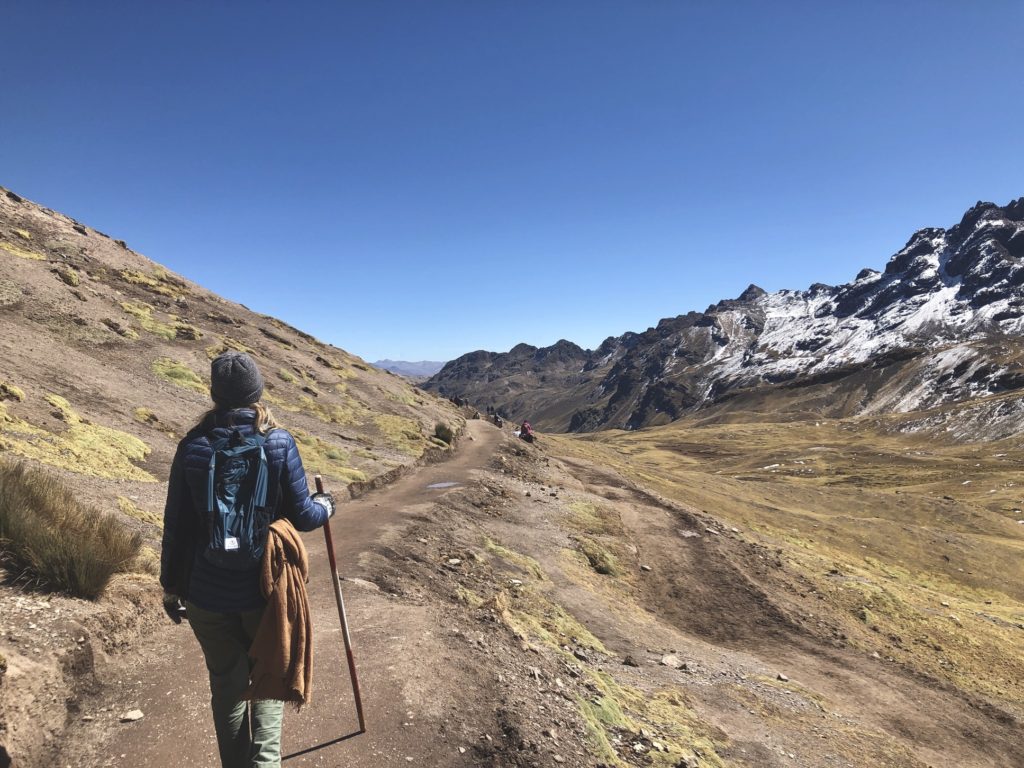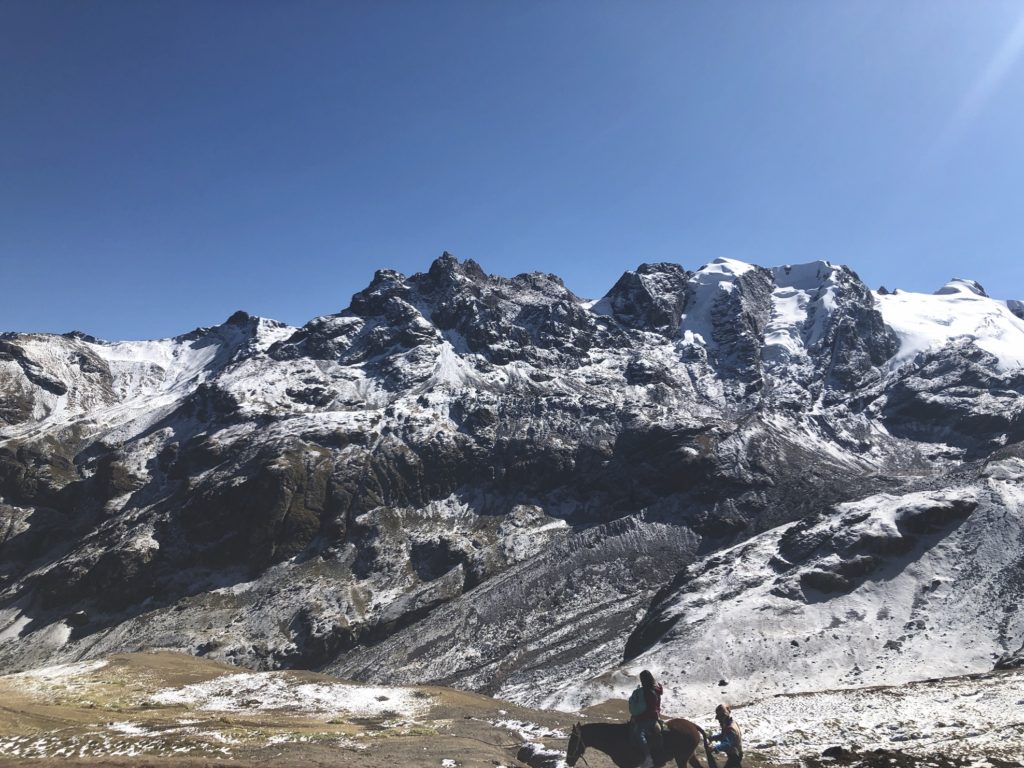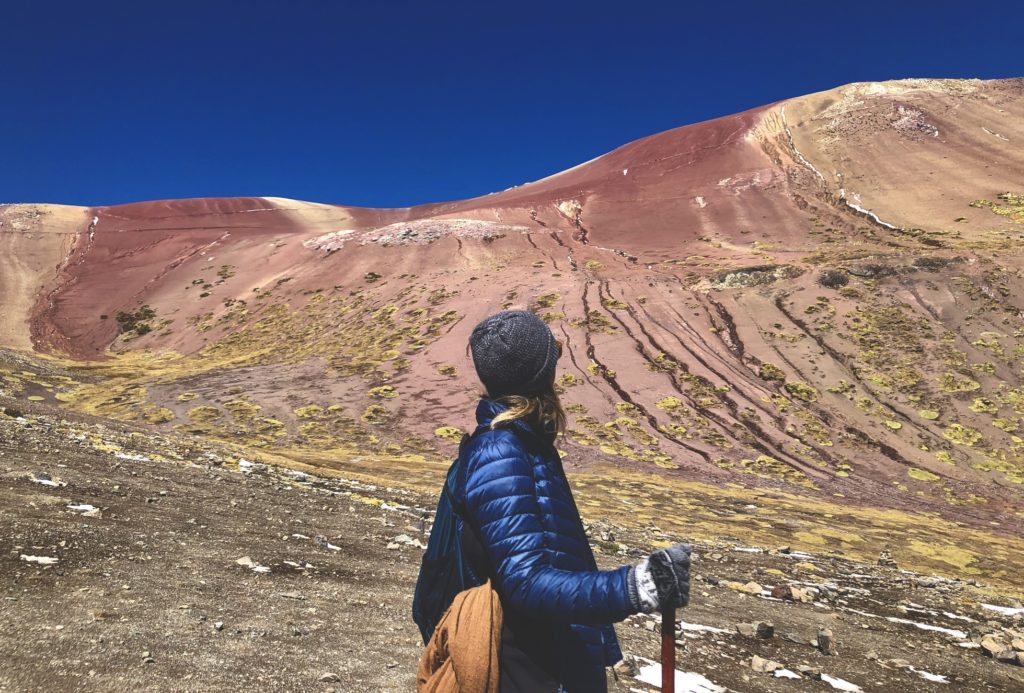RAINBOW MOUNTAIN: A DAY TRIP FROM CUSCO
There are many day trips from Cusco to choose from, and that’s great if you have time and money to do most of them, but if you’re like us and you don’t have unlimited funds and time, then you might have to choose only a few.
We chose Rainbow Mountain after catching glimpses of it’s beauty in photos in hostels and hotels throughout our journey around Peru. So when we arrived in Cusco and looked around for a one day excursion to complete before our inevitable Machu Picchu adventure, we couldn’t pass up that photogenic mountain. Besides Machu Picchu, we probably snapped our coolest looking photos atop the colorful Rainbow Mountain.
RAINBOW MOUNTAIN (VINICUNA)
It wasn’t too long ago that Rainbow Mountain was discovered by tourists and Peruvians alike. It really started in the past ten years, and still to this day, there isn’t a great passageway to get there. In fact, my cousin, who had traveled through Peru a few years prior to our trip, was surprised to see our photos and asked where it was. That’s because the drive takes you through a high altitude valley on a rocky road with steep cliff sides and dangerous terrain wasn’t constructed until 2015.
Warning: You just have to believe that these drivers have an abundance of experience driving through these mountainous roadways and nothing bad will happen, because that’s the only way you’re going to make it through the drive without freaking out. For peace of mind, I never seeked out any articles relating to tourists in shuttle buses tumbling down a mountain to their inevitable death. I just told myself that millions of people go to Peru and come back home, and that’s all you need to know.
On a lighter note, at this point towards the end of our three week journey, the drive through the valley to Rainbow Mountain was probably the most beautiful scenic splendor I witnessed. It’s hard to put into words the enormity of the Andes Mountains and the great distances and altitudes that the Native Americans had to travel and survive through.

BOOKING YOUR TRIP
This may not be true for all accommodations, but we discovered that the tour companies scattered throughout the towns and cities in Peru offered better deals on excursions than the hosts or concierges at our guest houses or hostels. As far as searching for the best deals go, it’s not worth it to seek out the best deal, because the tour companies pretty much charge the same amount for their excursion packages and offer the same experience.
You’re looking at about S/. 55 ($16) if you book it in Cusco, and more if you book it online (I don’t recommend). We booked ours the day before with no issues.
Although some tours do offer earlier departure times, around 2:00 to 3:00 AM to avoid the major crowds, the mountain could be covered in frost. You also want to make sure that the weather is suitable for good hiking conditions and, most importantly, great photo taking conditions. We were told that with rainy weather the colors don’t stand out as much, and obviously it’s never fun to hike in the rain. We were lucky enough to get perfect weather, but that’s common if you’re traveling through Peru in the winter months (the dry season), and not so much if you’re there November through April.
DRESS APPROPRIATELY
Make sure to dress in your warmest clothes, because there’s nothing worse than trying to sleep on a freezing cold bus at 5 in the morning without the proper attire. For me, the most important gear that I purchased for Peru were lined waterproof hiking boots and wool socks. For the shoes I went with the Men’s Moab 2 Mid Waterproof hiking boots. They can seem a bit pricey at first, but for the comfort, warmth, traction, water resistance, and lightweightedness there’s no better deal out there.

THE ROAD TO RAINBOW MOUNTAIN
In most cases the shuttle buses will pick you up at your hotel or hostel at 4 – 5 AM. Our amazing host from Inti Garden Cusco Boutique Hostel packed us some breakfast to tie us over until we stopped.
After about a two hour drive we stopped for breakfast at a little house for bread, butter, jam, fruit, and coffee or tea. To be honest, breakfast for us was never too impressive or filling in Peru, so we would always buy snacks and sandwich material at grocery stores whenever possible, and prepare our food the night before to have the next day when we got hungry.
After breakfast, it’s another 1.5 hour drive to the mountain, and for this stretch the sun is up so you can enjoy your surroundings. The last leg of the drive takes you through the valley and for a lack of a better word, it’s sketchy. Don’t expect your driver to take his sweet time navigating the treacherous unpaved switchbacks. He’s on a schedule and there’s no way he’s slowing down for anyone. But on the brightside, the views are spectacular, and it’s a conflicting feeling of danger and stunning natural beauty that makes the ride so exhilarating.
One minor, or possibly major detail, you possibly need to worry about is the altitude. While we were fortunate enough to acclimate to the high elevations in weeks prior, by doing hikes around Huaraz, Arequipa, and Lake Titicaca, some people did not have the same preparedness. A couple people in our bus got sick on the way up and once we arrived. Although, that could have been attributed to the windy roads and the speed at which we were driving them. Either way, it might be wise to keep a plastic baggy on hand for such possible occurrences.

THE ASCENT TO THE TOP
It is said that the hike used to be much longer than it is today and, for good reason, it was made much shorter by extending the road farther. Nowadays the hike starts at about 15,000 feet (4,600 meters), and at the top reaches altitudes of 17,000 feet (5,200 meters), not exactly a walk in the park. For this reason it’s important to stay close to your guide while you’re making the 1.5 – 2 hour ascent, because they provide oxygen if necessary, something a few people in our group required.
The hike is straight uphill the entire way to the viewpoint. We made sure to make frequent short stops to drink water, eat some snacks, and catch our breath. We were fortunately capable of making it to the top without oxygen assistance, but you do have the option of riding a horse most of the way up for a fee. The problem with the horseback ride is that it drops people off with another kilometer to go, and this is the most difficult stretch of the hike.
Just keep in mind that not all people make it to the viewpoint. We noticed many individuals, in much better shape than ourselves, that couldn’t make it to the top, and that’s nothing to be ashamed of. Unless you’ve trained yourself for high elevation hikes, you really can’t predict how your body is going to react to a lack of oxygen. The only homo sapiens in the world to have evolved to handle high altitudes are those of Tibet in Asia, the Andes of the Americas, and Ethiopia in Africa. So don’t beat yourself if you don’t make it to the top, there are amazing views from the trail, and your health is more important than getting that photo.

THE VIEW AT THE TOP
Don’t get me wrong, the view at the top is amazing, but it’s also packed with people. Those photos without people in them that you see on Instagram and travel sites are taken in just the right location and just the right angle to avoid people pollution. That’s not to say our experience was diminished by the crowds. With or without all the people, it’s still a breathtaking view and a once in a lifetime experience to behold.
Just make sure to put your layers back on before you get to the top, because the winds up there can freeze you to your bones in a heartbeat. We noticed people shivering as they were leaving and we were arriving, so we took that as a hint to bundle up before reaching the viewpoint.
They recommend about 20-30 minutes at the top to avoid altitude sickness, and to make it back to Cusco before sundown. It only takes about an hour to get back down to the bus. Just remember that it’s usually during the descent that most people injure themselves. Make sure to watch your step, look out for slippery stones, and take your time to avoid rolling an ankle or falling on your bum.

THE ROAD BACK TO CUSCO
Surprising to me, it was the road back through the mountainous valley that affected people the most. We stopped three times for people to vomit out the door of the bus, most likely because of the driver’s desire to return to Cusco so quickly, and as a result, a rapid change in altitude. I’m not trying to deter you from booking this excursion, but I think you should know about these things, so that you can take helpful measures to prepare yourself for such possibilities. We chewed on cacao leaves in Huaraz to help with the nausea, but obviously you can rely on modern medications to relieve altitude sickness symptoms.
We stopped for lunch on the way back at the same place. The meal was nothing special, but we were all hungry (except the pale faced people, of course) after a grueling hike and devoured our food. We were quickly back on the bus after filling up, hydrating, and relieving ourselves. There was one more quick stop overlooking a lake, but that was nothing to write home about.
OVERALL EXPERIENCE
We had a good time visiting Rainbow Mountain. The hike, while short, was a challenge, and the views were amazing and worth the price of admission. It certainly would have been a better experience without the massive crowds, but that comes with the territory. Afterall, any day trip around Cusco, the jumpoff point to Machu Picchu, is going to have overtourism.
Would I come back to Rainbow Mountain? Definitely not, but then again, I don’t like revisiting many places that I enjoyed. There’s too many places in this world to visit, and too little time to visit the same place twice. So enjoy this unique place high in the Andes Mountains once. Overtourism is only going to get worse, but that shouldn’t stop you from going, because places like Rainbow Mountain are popular for a reason.
